Shihao Bao Sophia
In the present world, over 5% of people have hearing loss1. Many people have heard about this name and know vaguely about it. However, they do not know deeply about why some people have hearing loss, how to diagnose hearing loss, and what is the treatment of hearing loss. Therefore, they do not know the needs and ways to help deaf and hard of hearing people.

Causes, diagnosis and treatment
In the present world, over 5% of people have hearing loss1. Many people have heard about this name and know vaguely about it. However, they do not know deeply about why some people have hearing loss, how to diagnose hearing loss, and what is the treatment of hearing loss. Therefore, they do not know the needs and ways to help deaf and hard of hearing people.
Before we talk about the causes of hearing loss, let’s know about the classification of hearing loss. There are five types, the classification is based on the different damage location of the auditory pathway.
1. Conductive: Occurs when the outer or middle ear prevents sound from reaching the inner ear and brain. Causes can include
• blockage of the outer ear or ear canal,
• an ear infection with fluid
• a malformation of the outer or middle ear.
2. Sensorineural: Usually the result of a problem with the cochlea, either through malformation or damage. Damage can occur from infections such as meningitis or as a side effect of certain ototoxic medications (toxic to parts of the ear). This type of hearing loss typically cannot be treated with medication.
3. Mixed: A combination of conductive and sensorineural hearing loss.
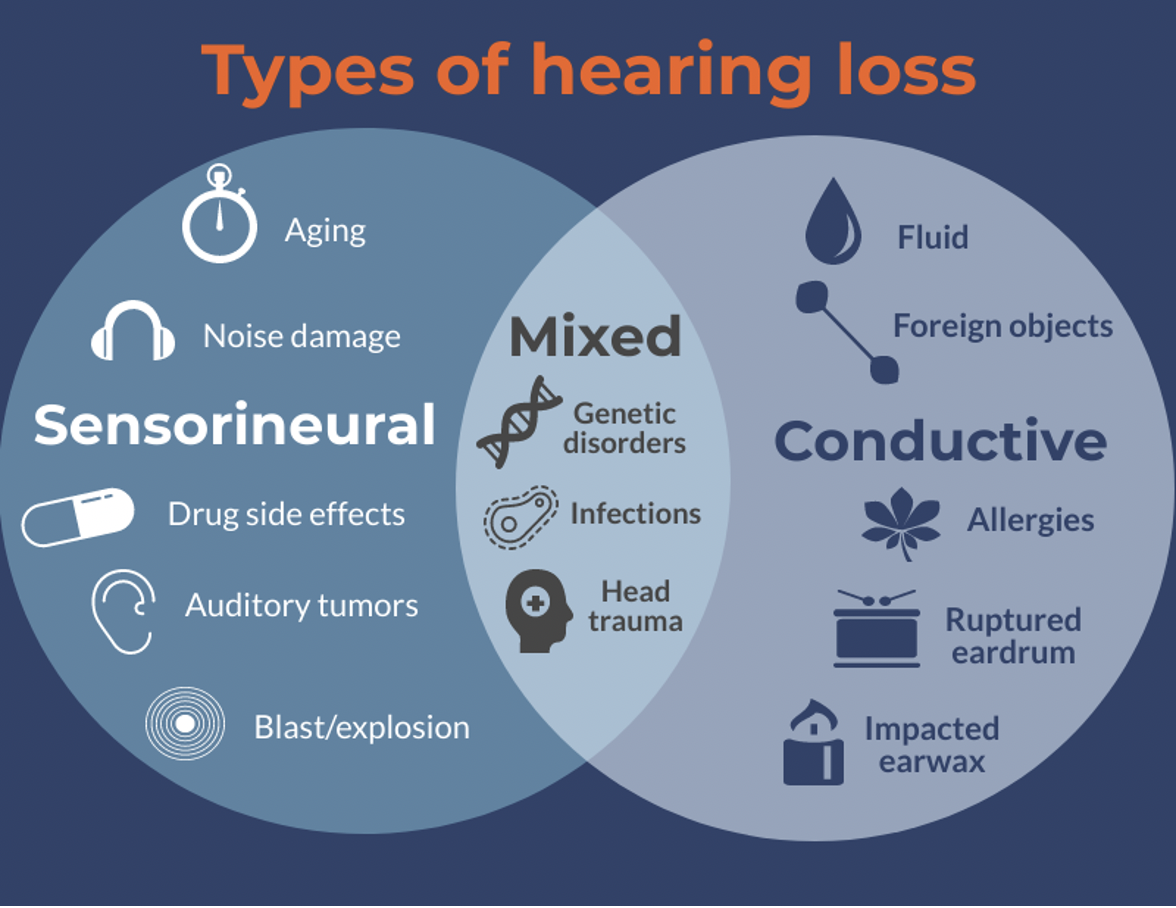
4. Neural: A rare condition resulting from damage or malformation to the auditory (hearing) nerve that connects the cochlea (inner ear) to the brain. The hearing loss is usually profound and permanent.
5. Auditory Neuropathy: Occurs when sound travels through the inner ear normally, but the further transmission of sound to the brain is impaired. Children and adults with Auditory Neuropathy Spectrum Disorder (ANSD) can have hearing loss that ranges from mild to severe, and the ability to understand speech varies widely.

What are the causes?
There are many causes of hearing loss, it is a multifactorial disease.
Genetic- In more than 50 percent of pediatric hearing loss cases, it is believed that genetic factors are the cause. Genetic or hereditary hearing loss occurs when a gene from one or both parents affect any portion of the outer, middle, or inner ear, causing varying degrees of hearing loss.
Prenatal Exposure- In some cases, an in-utero infection, illness, or toxin during the mother's pregnancy can be passed on to a baby in utero and cause hearing loss.
Perinatal Experiences- Procedures performed or medications used to save a baby's life in an emergency (such as using a ventilator or a strong antibiotic) can also affect hearing.
Acquired Hearing Loss - When hearing loss occurs after birth, it is often due to factors such as:
• Chronic ear infections also called otitis media: Are a common issue for many children and typically cause only temporary hearing loss. However, prolonged issues without treatment or repeated cases can affect hearing and cause more permanent damage.
• Ototoxic drugs: Usually prescribed to treat serious problems such as meningitis, this class of medications can affect hearing.
• Disease: Conditions such as otosclerosis, Ménière's disease, meningitis, and mumps can affect hearing. The impact on hearing varies depending on the cause, severity, and duration of treatment.
• Head injury: Head trauma can dramatically affect hearing, especially in children who are still growing.
• Perforated eardrum: Ear infections, head trauma, or the insertion of a foreign object into the ear (small toys, pens, cotton swabs, ear candles, etc.) can damage the eardrum. A perforated or torn eardrum will frequently heal with proper treatment, and the accompanying hearing loss may be temporary.
Unknown Causes - In some cases, it may be impossible to pinpoint why a person is deaf or hard of hearing. This could lead to not knowing the best treatment for a person.
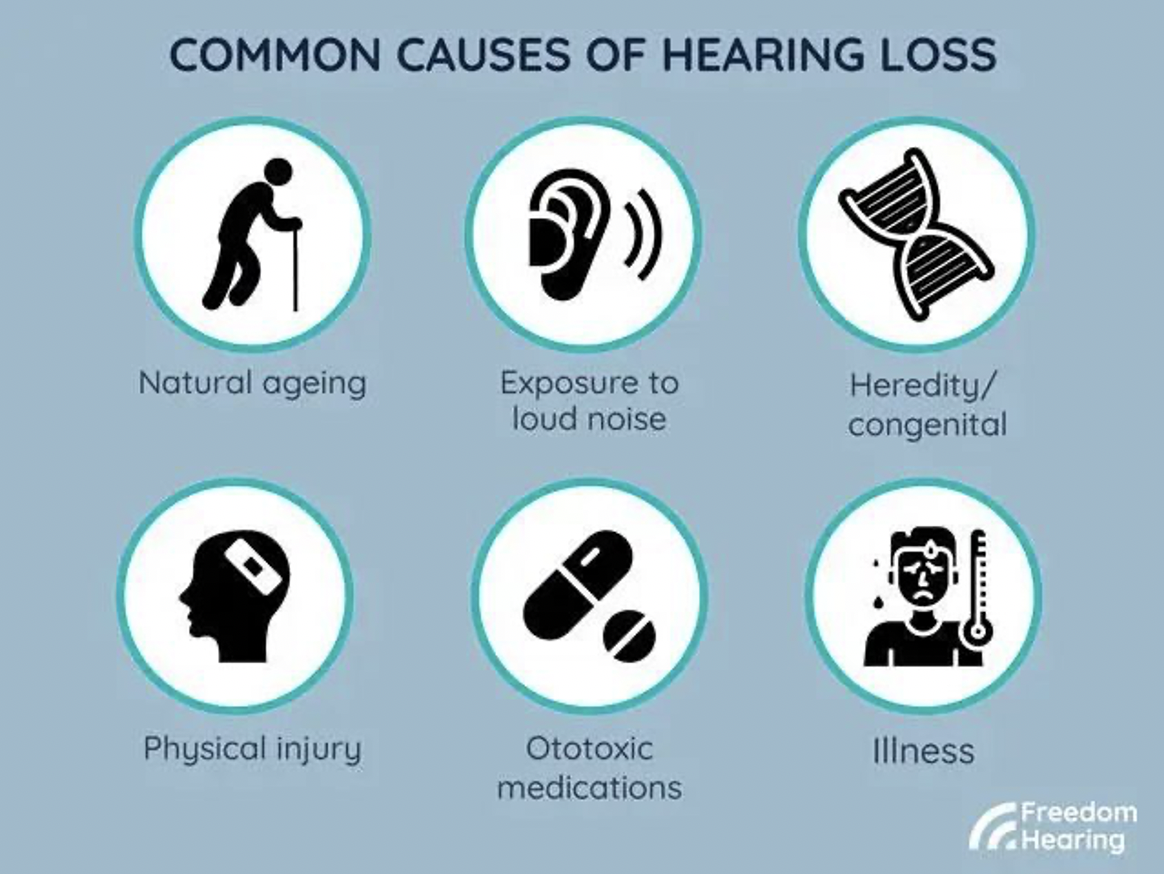
How do we diagnose hearing loss?
To diagnose whether people have hearing loss is very easy, just by finding out that people cannot hear what other people say, or from a yearly health check with a doctor. While how to do the diagnosis of what level of hearing loss people have usually need a professional test like the list below.
1. General screening tests. Doctors may use the whisper test, asking people to cover one ear at a time to see how well people hear words spoken at various volumes and how people respond to other sounds. Its accuracy can be limited.
2. Physical exam. The doctor will look in people's ears for possible causes of hearing loss, such as earwax or inflammation from an infection. Doctors will also look for any structural causes of people's hearing problems.
The picture shows how ear wax may affect the volume of sound people are hearing.
3. Tuning fork tests. Tuning forks are two-pronged metal instruments that produce sounds when struck. Simple tests with tuning forks can help doctors detect hearing loss. This evaluation may also reveal where in people's ear the damage has occurred.
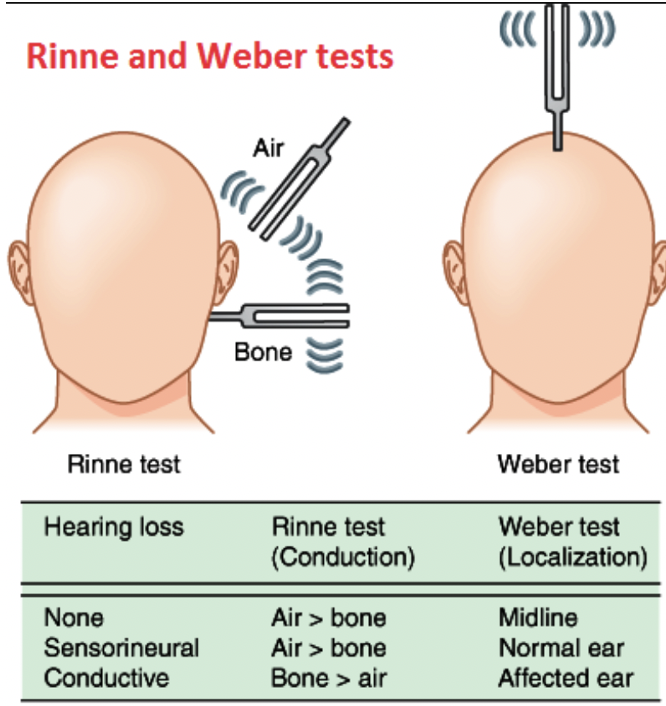
4. Audiometer tests. During these more-thorough tests conducted by an audiologist, people wear earphones and hear sounds and words directed to each ear. Each tone is repeated at faint levels to find the quietest sound people can hear.
5. App-based hearing tests. Mobile apps are available that people can use on their tablets to screen for moderate hearing loss every day.
After these tests, the audiologist or doctor would produce a graph like the following picture.
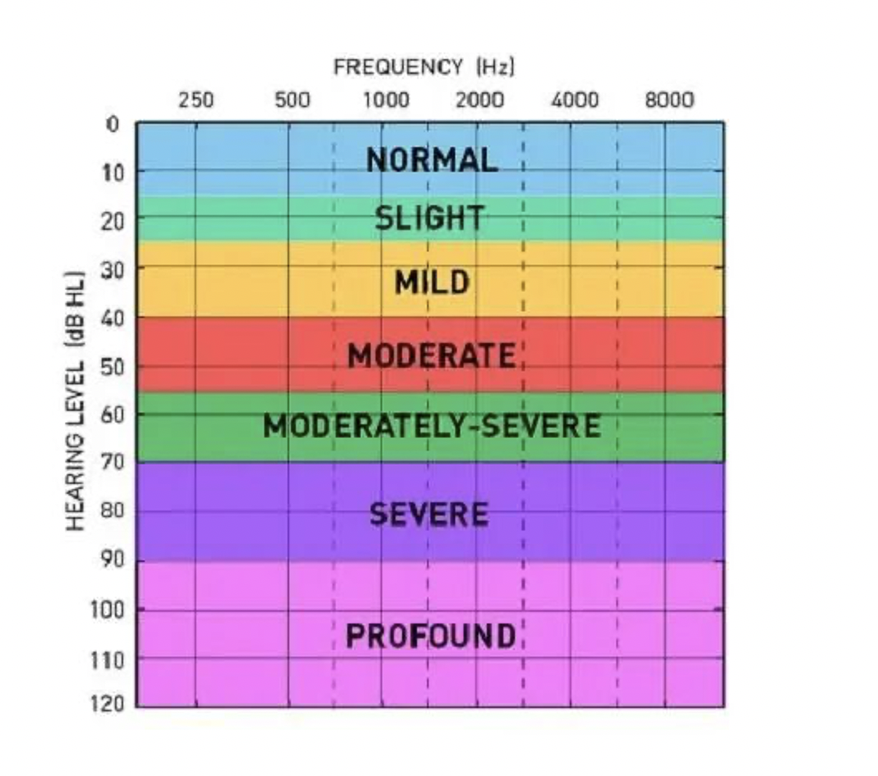
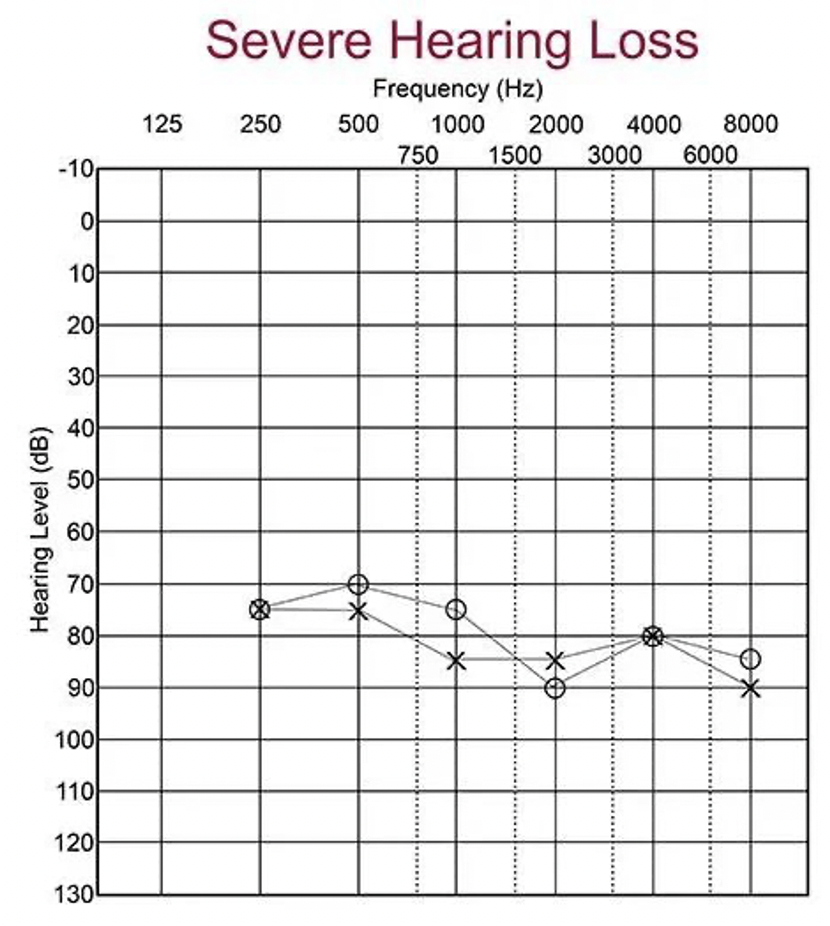
The graph on the left shows the different levels of hearing loss and where the graph would be drawn in different cases. The graph on the right shows the frequencies of a severe hearing loss patient.
The graph is key to treatment for the patient, as it tells audiologists what type of treatment is suitable for the patient.
Treatment of hearing loss
The treatment for hearing loss varies from person to person, and it also depends on different types of hearing loss.
Treatment for conductive hearing loss
1. Hearing instruments such as hearing aids or implants such as bone conduction devices.
2. Surgery:
a. Stapedectomy. This surgery is a treatment for a disease called otosclerosis. In otosclerosis, the smallest bone in the ear, the stapes, becomes fixed to the surrounding bone resulting in conductive hearing loss. The surgery will replace this bone with a prosthesis, significantly improving sound conduction and hearing.
b. PE Tubes. This surgical treatment involves placing a small tube through the eardrum to allow air into the middle ear. This surgery is commonly performed in children or adults due to chronic middle ear fluid and infections. This fluid frequently clears without surgery but can sometimes linger and cause hearing loss and severe damage to the middle ear. These tubes can help restore hearing by draining the fluid and healing the inflammation in the middle ear.
c. Middle Ear Surgeries. Some diseases of the middle ear can also cause conductive hearing loss. The two most common causes of this loss are a hole in the eardrum or erosion of one or more hearing bones. When there is a hole in the eardrum, the sound is not transmitted appropriately to the hearing bones and into the inner ear. Similarly, when the hearing bones are not joined together, the sound is not effectively conducted from the eardrum to the inner ear. Surgical interventions can fix holes in the eardrum or replace missing hearing bones with prosthetic bones.

Treatment for Sensorineural hearing loss
1. Hearing aids. If hearing loss is due to damage to people's inner ear, a hearing aid can be helpful. An audiologist can discuss with the patient the potential benefits of a hearing aid and fit people with a device. Open fit aids are currently the most popular due to the fit and features offered.
2. Cochlear implants. A cochlear implant may be an option if people have more severe hearing loss and gain limited benefits from conventional hearing aids. Unlike a hearing aid that amplifies sound and directs it into people's ear canal, a cochlear implant bypasses damaged or non working parts of people's inner ear and directly stimulates the hearing nerve.
3. Medical treatment, drugs like FX-322 to help with hearing loss
FX-322 drug is used to regenerate auditory sensory hair cells located in the cochlea within the inner ear and potentially restore hearing in individuals with sensorineural hearing loss. Research has shown that the hearing of individuals administered with a single dose of FX-322 may improve over extended periods. The longer-term measures of their treated ear demonstrated word recognition score improvements compared to pretreatment baseline levels, and no significant changes were detected in their untreated ears. Of the five subjects with a statistically significant response at day-90, the four who returned for evaluation had scores above their baseline word recognition measures. However, they were below the threshold for statistical significance.
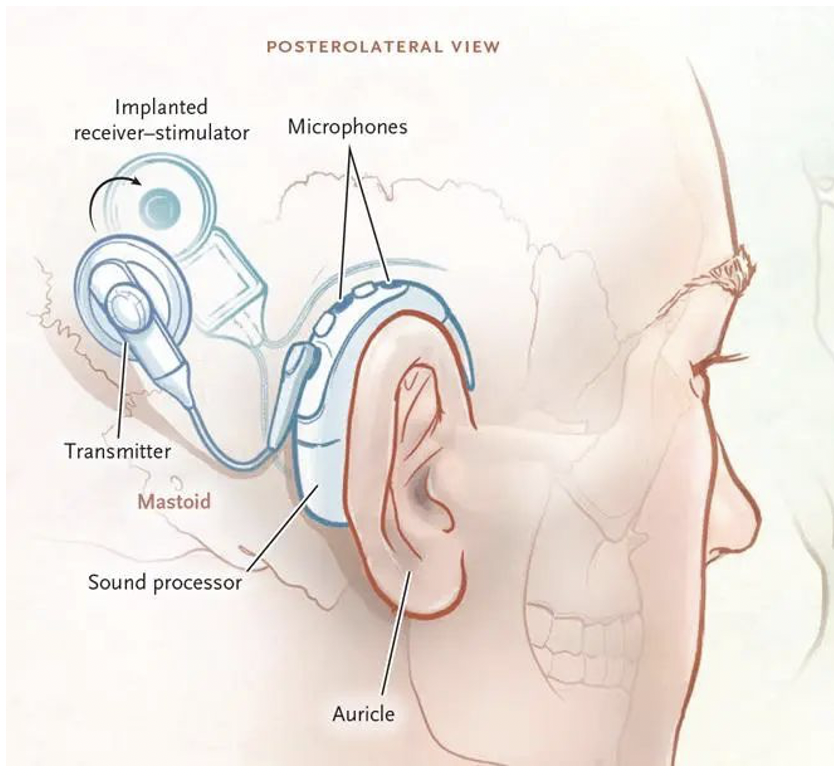
4. Gene therapy of the TMC-1 and TMC-2 genes. This gene is essential to hearing and transferring sound waves to electrical signals for the brain to understand.
a. The researchers tested gene therapy in two types of mutant mice. One type had the TMC1 gene completely deleted and is a good model for recessive TMC1 mutations in humans: Children with two mutant copies of TMC1 have profound hearing loss very young, usually by two years of age.
b. The other type of mouse, Beethoven, has a specific TMC1 mutation—a change in a single amino acid—and is a good model for the dominant form of TMC1-related deafness. In this form, less common than the recessive form, a single copy of the mutation causes children to gradually go deaf beginning around 10 to 15 years of age.
c. In both cases, to deliver the healthy gene, the team inserted it into an engineered virus called adeno-associated virus 1, or AAV1. They then injected the virus into the inner ear of both mice. They got the following results:
• In the recessive deafness model, gene therapy with TMC1 restored the ability of sensory hair cells to respond to sound—producing a measurable electrical current—and restored activity in the auditory portion of the brainstem.
• Most importantly, the deaf mice regained their ability to hear. The researchers placed the mice in a "startle box" to test hearing and sounded harsh, loud tones. Mice with TMC1 mutations will sit there, but they jump as high as a standard mouse with gene therapy. (The force of their jump was measured by a plate on the floor underneath them and was detectable at sounds beginning around 80 decibels.)
• In the dominant deafness model, gene therapy with a related gene, TMC2, was successful at the cellular and brain levels and partially at restoring actual hearing in the startle test.
Clinical trials for gene therapy are on the horizon, as AAV1 is shown to be safe to be used in the human body. Although the technology is currently only used and tested on mice, clinical trials are expected to start within a few years.
5. Stem cell transplantation. Stem cell therapy involves transplanting new stem cells into the inner ears. The delicate hairs inside our cochlea, or inner ear, help us hear. Damage to these hairs can lead to permanent hearing loss. Stem cells can function like other cells and also make new cells. These transplanted stem cells can behave exactly like the inner ear hairs and help restore hearing.
a. Neural stem cells (NSCs) are multipotent stem cells that can differentiate into neurons or glial cells isolated from the hippocampus and cerebral cortex. Several studies have shown promise in using these NSCs in treating sensorineural hearing loss by replacing spiral ganglion neurons or by replacing inner ear hair cells.
b. Embryonic Stem Cell (ESC) Therapy. The first study to be performed with ESCs in attempt to improve sensorineural hearing loss was in 2003x. The study demonstrates a protocol for generating inner ear progenitor cells in large numbers, which displays the promise of using ESC-derived progenitor cells in vivo in human patients to treat deafness.
c. Mesenchymal Stem Cell (MSC) Therapy. A study performed in 2007x led by Sang-Jun Jeon of the Harvard Medical School shows positive results of this study indicate that MSCs are a viable choice for replacing damaged or lost hair cells when combined with the overexpression of Math1
d. Induced Pluripotent Stem Cell (iPSC) Therapy. iPSCs are formed by the forced expression of several transgenes, usually a mixture of Oct3/4, Sox2, Klf4, and c-Myc, which can reprogram human, mouse, rat, monkey, and dog somatic cells. The results of the experiment from Stanford University School of Medicinex demonstrates the possibility of using iPSCs, as well as ESCs, to generate mechanosensitive hair cell-like cells that could replace hair cells in cases of hearing disorders
e. Based on all the studies, all four types of stem cells show potential to treat and improve sensorineural hearing loss.

Treatment for neural hearing loss
There is currently no treatment for neural hearing loss, as cochlear implants have to use the neural nerve to transport signals to the brain; brain implants have been used with limited success in this situation.
Treatment for Auditory Neuropathy hearing loss
1. cochlear implant – a surgically implanted device that stimulates the nerves of the inner ear
2. frequency modulation (FM) systems -FM systems are wireless assistive hearing devices that enhance hearing aids cochlear implants and assist people who are hard of hearing but do not wear hearing aids, particularly over distance and in noisy environments.
3. hearing aids
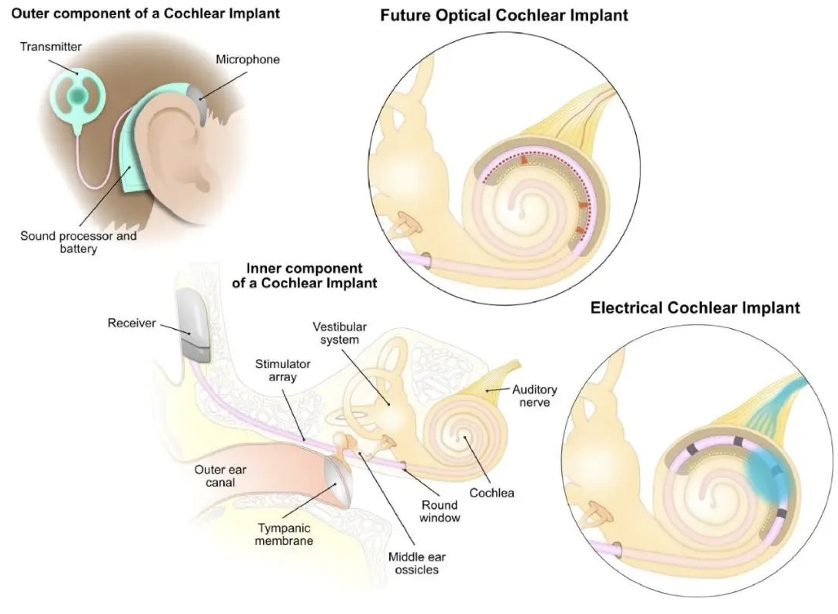
Reference:
Amieva & Ouvrard, 2020;
Chandrasekhar et al., 2019;
FM Systems, n.d.;
Frequency Therapeutics Announces New FX-322 Results Showing That Additional Study Participants Gain Hearing Improvements at Later Time Points - Frequency Therapeutics, n.d.;
Fw: 机械敏感通道的研究n.d.;
Gene Therapy Restores Hearing in Deaf Mice, n.d.;
Hearing Loss Explained, n.d.;
Stem Cell Treatment for Hearing Loss, n.d.;
Surgical Treatment for Hearing Loss | TriHealth, n.d.;
The Use of Stem Cells in the Treatment of Sensorineural Hearing Loss, n.d.; What Is an Audiogram? – Understanding Hearing Test Results | Babyhearing.Org, n.d.;
Groves et al., 2013, p. 28, 2013; Hu et al., 2016; Jia et al., 2020, p. 1;
Ma et al., 2019; McLean et al., 2016;
Pivetti et al., 2003; Yin et al., 2014)